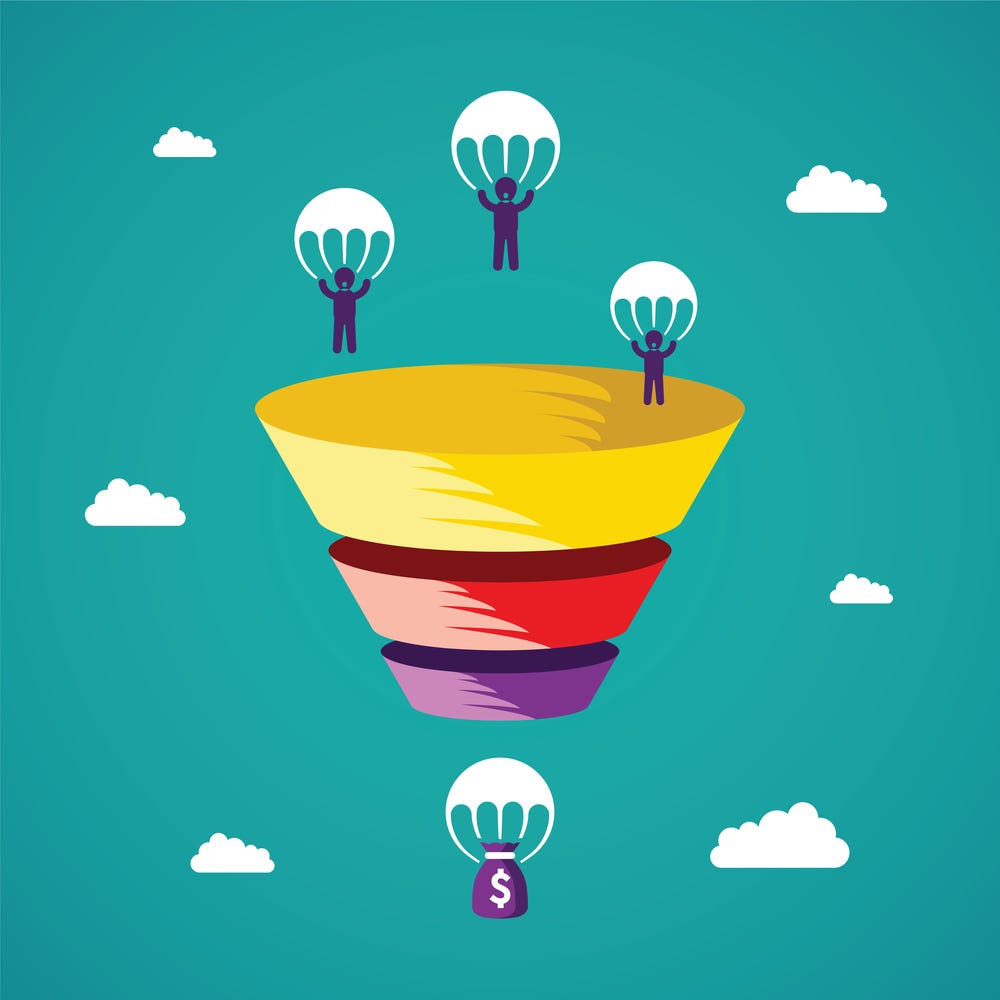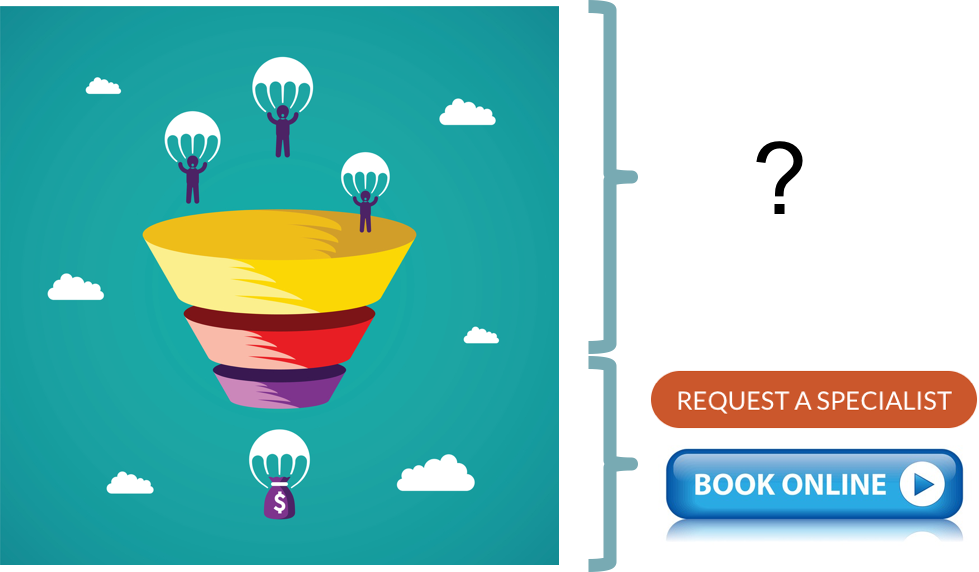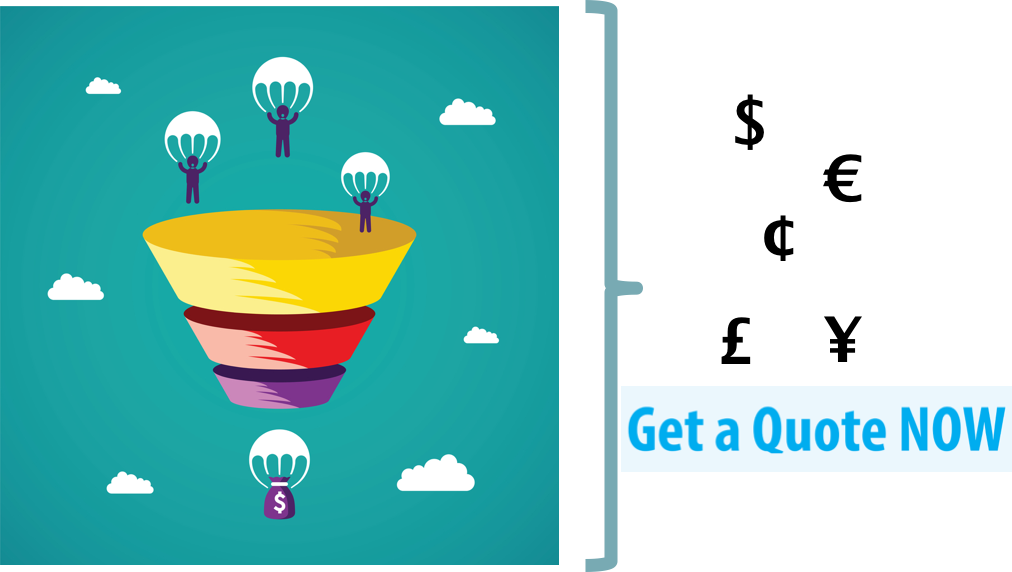What do price transparency and sales funnels have in common? I’ve repeatedly mentioned the importance of price transparency on my blog. And not just price transparency, but using price transparency as a lead generation tool for medical practices. Now, let me explain how your medical practice fits the sales funnel paradigm just like any business to consumer (B2C) business out there.

Sales funnels: a review
As any business that works directly with consumers knows, much of your time is spent online, generating leads. When a consumer arrives to your website, we rely on buttons or links — a call to action — to galvanize the consumer to give us their contact info (a lead) in exchange for more information.
If you imagine a sales funnel like the one to the left, your business can potentially gather many leads and nurture their passage from the top to the bottom of the sales funnel. They may enter your sales funnel at any point from top to bottom. However, initially, everyone starts at the top of the sales funnel. But maybe they started in someone else’s sales funnel before finding your site? Let me explain.
Every consumer initially recognizes a problem they have and then starts looking for an answer to that problem. In a very general sense, they’re already progressing through a sales funnel without even knowing it. A commercial or ad makes them realize there’s a solution to their problem. This is when they start their research phase (at the top of the funnel). As they do more research, hopefully they find your website. By then, they may be ready to commit to a medical or cosmetic treatment. So while they initially entered the funnel at the top, they could be entering your funnel towards the bottom, ready to “request a specialist” or “book online” as in the funnel diagram below. In other words, by the time they “meet” you or your facility online, they could be ready to make a decision.

And that’s great when someone enters your office or facility ready to book a procedure. That means you caught them at just the right time, towards the bottom of the funnel. But what about everyone else within that sales funnel (as denoted by the ‘?’ above)? They’re still interested in your services. They’re still a potential client. So don’t dismiss them just because they’re not as ready to book at the moment. Eventually they will be.
It’s a marathon, not a sprint
There’s no better feeling than someone responding to your call to action and booking immediately. But not everyone is there. So even though it may take a consumer longer to make a decision to move forward with treatment at your facility, it’s still worthwhile capturing them as early as possible in their journey. As I stated, everyone initially enters the funnel towards the top, at the beginning of their research process. Therefore, it would behoove you to ensure they’re entering your funnel at the top, not some other provider. A lead is important, no matter where they are in the funnel. Better to capture and nurture as many leads as possible because eventually, statistically, they’ll be paying patients.

So what’s the best call to action to capture everyone from the top to the bottom of your funnel? A call to action that taps into everyone’s curiosity: how much the procedure costs! That’s right. Price transparency, as embodied by a “Get a Quote Now” button ensures that you’ll generate a ton of leads for your practice. With this Price Estimator type of call to action, the consumer submits a “wishlist” containing their procedures-of-interest along with their contact info. The consumer immediately receives a cost estimate and the provider receives the consumer’s contact info — the lead.
Again, they may not all be ready to book at that very moment. But as I said before, they’ll eventually get to the bottom of that funnel so best to know who they are early on. If you have a consumer’s email address early in their research phase, you can remarket to them via an email marketing campaign.
Those that need time to decide will eventually move forward. Chances are they’ll take the path of least resistance and go to the doctor (you!) whose email newsletter is sitting in their inbox. And even if they still don’t come in for treatment, they could forward your email to a family member or friend that’s looking for a doctor.
How long will it take to convert a lead?
You have to be willing to capture leads and wait. Certainly some will convert quickly but most will take time. A recent review of leads from our price transparency website revealed something very interesting. Consumers that submitted three or more “wishlists” to a doctor waited 41.4 days on average between submitting each of their wishlists. Keep in mind, that’s the average. The minimum time between pricing inquiries was 10 seconds, while the longest was 3.6 years!
Regardless, don’t kid yourself. Healthcare is more competitive than ever. Resting on your laurels waiting for referrals isn’t good enough. More consumers are going out of network and shopping around. Capturing leads is critical to provider success. And hopefully, by now, you’ll agree there’s no better way to capture leads than through price transparency!
Click here for the original blog post written by Dr. Kaplan for BuildMyBod.
Dr. Jonathan Kaplan is a board-certified plastic surgeon based in San Francisco, CA and founder/CEO of BuildMyBod Health, an online marketplace for healthcare services that allows consumers to determine cost on out-of-pocket procedures, purchase non-surgical services, and in exchange, the healthcare providers receive consumer contact info — a lead, for follow up.







